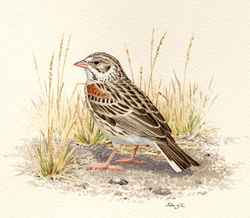Find a Bird - BBA1
Breeding Bird Atlas 1 Species Accounts
Vesper Sparrow
Pooecetes gramineus
State Status
Threatened
Egg Dates
April 11 to August 11
Number of Broods
one or two

The Vesper Sparrow is an uncommon and local summer resident. In Massachusetts, the decline of this species, which Forbush (writing at the beginning of the last century) characterized as a common summer resident, is associated with the demise of agriculture. In the latter half of the nineteenth century, during the so-called “period of abandonment,” many Massachusetts farms were let go. Typically, the first farms to be abandoned were the poor-soil farms in upland situations. It was these same upland areas of pasture and short grass fields that provided optimal habitat for the Vesper Sparrow.
Another factor that may have been involved in this sparrow’s decline relates to its territorial requirements. Because the Vesper Sparrow needs a larger territory than many of the sparrow species, apparently suitable habitat may be unused due to its relatively small size or fragmentation. During the Atlas period, the species was found in widely scattered locales across the state, with most confirmations and probable nesting near the coast and in the Connecticut River valley.
Vesper Sparrows return to Massachusetts in late March or early April. Resident birds establish territories in pasturelands, on rural airports and military reservations, in agricultural fields, in cleared areas of pine barrens, and on coastal moors. These habitats are normally well drained, with sandy or rocky soils. Early in the season, the males patrol these territories, making frequent use of prominent perches to advertise their presence vocally. The Vesper Sparrow does not confine its singing to evening song. In fact, its vocal efforts may be heard throughout the day, particularly before the first eggs are laid. The song begins with two low, slurred notes, which are followed by two high notes, and concludes with a descending and rapid jumble of trills. A chirp call note is common.
During courtship, the male moves about the female on the ground with his wings held open and his tail spread. The nest, consisting of dried grasses and rootlets, is built in a slight depression in the ground. Typically, four or five eggs are laid, which are incubated by both parents (mostly the female). Clutch sizes for 6 Massachusetts nests were three eggs (1 nest), four eggs (4 nests), five eggs (1 nest) (DKW, ACB, BOEM). The incubation period has been reported as 11 to 13 days.
Disturbance of a nest after the young have hatched usually results in an injury-feigning distraction display. The female does most of the brooding of the small nestlings and also shields them from the sun. A nest in eastern Massachusetts contained four young (BOEM). Fledging occurs from 7 to 12 days of age. Vesper Sparrows often raise two broods per season, with the male taking charge of the young while the female begins a new nest. Both adults and immatures will linger in the vicinity of the nest site well after the last young has fledged. Juveniles continue to receive some food from the parents until they are 30 to 35 days old.
Vesper Sparrows can be very inconspicuous as they forage for insects and weed seeds, often allowing a close approach before flushing and flying off low with the white outer tail feathers flashing. Many observers have noted this species’ fondness for dust bathing. Adults have a complete molt after nesting is completed, and the young assume winter plumage during this time. Twenty-five years ago, relatively large flocks of Vesper Sparrows were noted during autumn migration. Present-day sightings during September and October, away from known nesting sites, are usually limited to individual birds or groups of two to three. Migration continues into November. Only rarely do individual Vesper Sparrows attempt to overwinter. Most travel to the southern states and Mexico.
The Vesper Sparrow is listed as a threatened species in Massachusetts.
Map Legend and Data Summary
Atlas 1 data collected from 1975-1979


Note: very uncommon and local in coastal moors and in agricultural areas inland, declining
Richard K. Walton



